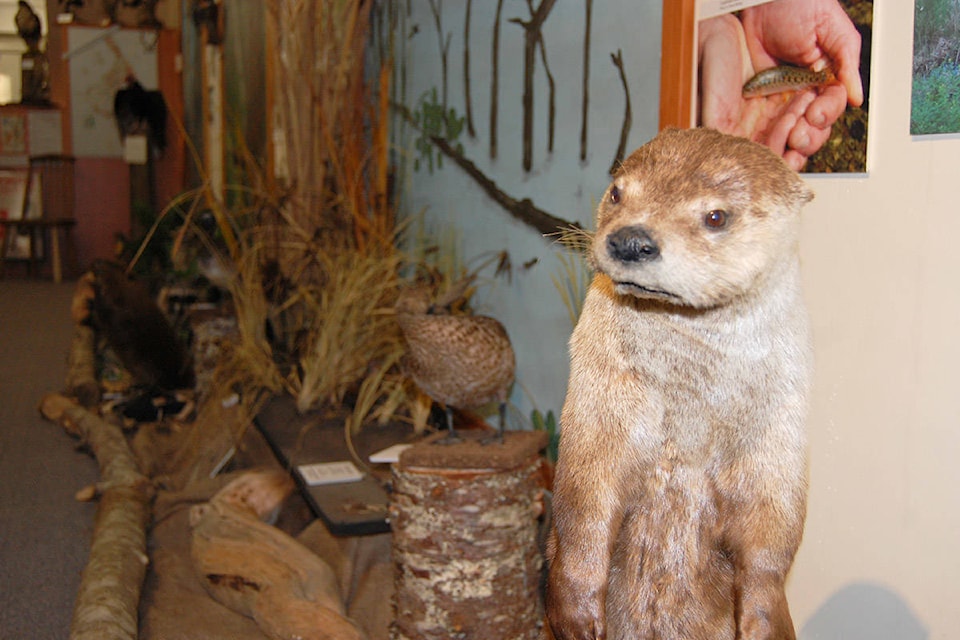Mounted skins of a turkey vulture, a barred owl and a river otter are among the dozens of animals featured at an exhibit on Cortes Island.
Wild Cortes showcases the work of Laurel Bohart, a veteran taxidermist who says she has worked on “many hundreds” if not thousands of animals.
She started learning about the craft in Nigeria, where her parents were medical missionaries in the 1960s and 1970s amid civil war.
Another family of missionaries was involved in hunting and “they taught me how to skin my first bird when I was 11,” Bohart said in an interview. She learned to hunt and began to collect birds.
| A mounted barred owl appears to keep watch over the Wild Cortes exhibit. Photo by David Gordon Koch/Campbell River Mirror |
Bohart learned more about the craft from her grandfather, who lived in Ladysmith. He managed an Overwaitea grocery store and also practised taxidermy.
Over the years, she obtained a master’s degree in museum science at Texas Tech University and opened a taxidermy business with her first husband in Duncan.
Many of her “study skins” – unmounted skins used in scientific studies – can be found at the natural history museum at Vancouver Island University, where she studied in the 1970s when it was known as Malaspina College.
“We did shrews, bats, mice, rats, just about everything,” she said.
Bohart, who lives in Squirrel Cove, said that Wild Cortes probably contains upwards of 80 of her mounted works, along with perhaps 30 or 40 study skins.
| Mounted turkey vulture at the Wild Cortes exhibit. Photo by David Gordon Koch/Campbell River Mirror |
READ MORE: Cortes Community Radio appeals for funds following transmission failure
Strict regulations mean that animals like raptors must be found dead, she explained, though hunters can mount the heads of animals like deer. When a carcass is found in good condition, the government must be notified before it issues a permit for the remains to be stuffed.
“You’ve gotta have papers with you,” she said.
She mostly works on birds and smaller animals, lacking storage space for larger animals. Working on huge creatures like moose is also physically demanding.
“Yes, I have done moose. No, I don’t want to ever do another moose, thank you,” she said. “I don’t have the strength. I have too many health issues to do that.”
I recently visited the Cortes Wild exhibit, which features dozens of animals stuffed by veteran taxidermist Laurel Bohart. The Cortes Island resident told me she learned the craft as a young child of missionaries in Nigeria. More to come. pic.twitter.com/bsuMWToiON
— David Gordon Koch (@davidgordonkoch) August 21, 2019
Children are fascinated by the stuffed creatures, said Bohart, who has demonstrated the taxidermy process at Cortes Island School. She is also holding demonstrations on Saturdays at the Wild Cortes gallery.
“I worked on a shrew and a mouse last week,” she said.
Kids are allowed to touch most of the mammals, but not the birds, since oils on human hands can damage feathers.
The exhibit is a good jumping-off point for nature hikes, since it gives people an opportunity to see stuffed specimens of animals they’re trying to identify in the wild, says Lynne Jordan, president of the Cortes Island Museum and Archive Society.
The array of animals was formerly housed at the main museum, located at Mansons Landing. When they were placed in storage, visitors often inquired about the collection, so Jordan went looking for grant money and a permanent home for the birds and beasts.
The exhibit eventually found a home in a former school at nearby Linnaea Farm, an organic farm geared towards ecological land stewardship and education. The Wild Cortes exhibit was installed as a permanent satellite gallery in April 2018.
| Wild Cortes is located at the Linnaea Farm on Cortes Island. Photo by David Gordon Koch/Campbell River Mirror |
The volunteer-run Wild Cortes exhibit is one of several educational initiatives at the site. It’s linked to the Children’s Forest Trust, an effort to preserve lands adjacent to Carrington Bay Regional Park, also on Cortes Island. Jordan said locals are trying to raise funds to buy the land from Island Timberlands, a forestry company.
As for Bohart, she said she’s driven to continue her work out of a love for taxidermy and sheer curiosity.
“When I find a perfect specimen, I’m totally overjoyed,” she said. “I know I’m weird.”
To learn more, visit cortesmuseum.com.
@davidgordonkoch
david.koch@campbellrivermirror.com
Like us on Facebook and follow us on Twitter
